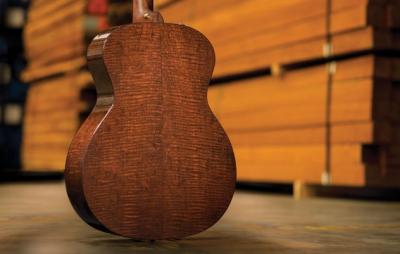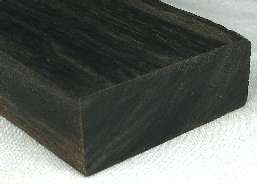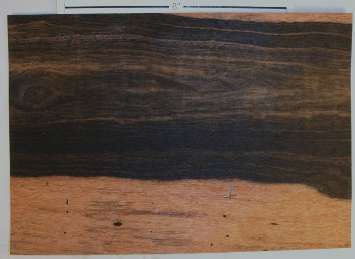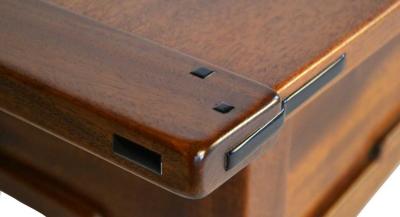Paying for Sustainable is Good, but Expanding What's Acceptable is Better
Primary tabs
 There was an interesting crossover to woodworking in the latest Alton Brown podcast. Yes, I like Alton Brown; he cooks, he's funny, and he's a geek. Don't give me any shit about it. I get enough on the topic from my wife. She can't stand him, for some reason. So the Alton Browncast is normally about cooking and food related items, but in the last couple of weeks, he's branched out to talk about other topics that interest him. Episode 18 has him doing a 90 minute long interview with the founder of Taylor Guitars, Bob Taylor. It's a fascinating and wide-ranging discussion; they talk about the start of the business, ways to market your work, the production process, and food and diet, among other things. (Bob has just recently become a vegan, for health reaons.)
There was an interesting crossover to woodworking in the latest Alton Brown podcast. Yes, I like Alton Brown; he cooks, he's funny, and he's a geek. Don't give me any shit about it. I get enough on the topic from my wife. She can't stand him, for some reason. So the Alton Browncast is normally about cooking and food related items, but in the last couple of weeks, he's branched out to talk about other topics that interest him. Episode 18 has him doing a 90 minute long interview with the founder of Taylor Guitars, Bob Taylor. It's a fascinating and wide-ranging discussion; they talk about the start of the business, ways to market your work, the production process, and food and diet, among other things. (Bob has just recently become a vegan, for health reaons.)
 But from my perspective, the most interesting aspect of the interview came in the first half, from about the 20 minute to the 45 minute mark. Due to the recent legal difficulty at Gibson Guitars over improperly sourced exotic woods, it's clear that the entire industry has had to take a new look at their wood supplies. And it sounds as if Bob Taylor has done more than anyone to come up with a new way of suppling their factories with the woods they need. If anyone is doing yeoman's work at pointing us all in a new sustainability direction in this area, it sounds like Mr Taylor is at the forefront. It's an interesting listen to hear him talk, with passion and thoughtfulness, about travelling around the world to find the finest woods for his production; to Alaska for Sitka spruce, to three small mountain villages in Honduras for rosewood, and to Camaroon for ebony. It's the latter tale that has the most intrugue, and raised the biggest questions for me.
But from my perspective, the most interesting aspect of the interview came in the first half, from about the 20 minute to the 45 minute mark. Due to the recent legal difficulty at Gibson Guitars over improperly sourced exotic woods, it's clear that the entire industry has had to take a new look at their wood supplies. And it sounds as if Bob Taylor has done more than anyone to come up with a new way of suppling their factories with the woods they need. If anyone is doing yeoman's work at pointing us all in a new sustainability direction in this area, it sounds like Mr Taylor is at the forefront. It's an interesting listen to hear him talk, with passion and thoughtfulness, about travelling around the world to find the finest woods for his production; to Alaska for Sitka spruce, to three small mountain villages in Honduras for rosewood, and to Camaroon for ebony. It's the latter tale that has the most intrugue, and raised the biggest questions for me.
 The supply of true African ebony for guitar production is almost gone. And the methods the industrialized world has pushed have become woefully outdated. And he emphasized something about ebony that has tickled around at the edge of my concsciousness but never quite materialized for several years. When asked about sourcing ebony, and whether people would be willing to pay more for the real source material, he actually switched the conversation. Yes, people will need to pay more for real ebony in their instruments, he argues, but people will also have to consider changing their aesthetic requirements as well. In the guitar making canon, as in almost every place that ebony is used, the term 'ebony' means someing like the wood shown at right. It's a pure black, homogeneous material.
The supply of true African ebony for guitar production is almost gone. And the methods the industrialized world has pushed have become woefully outdated. And he emphasized something about ebony that has tickled around at the edge of my concsciousness but never quite materialized for several years. When asked about sourcing ebony, and whether people would be willing to pay more for the real source material, he actually switched the conversation. Yes, people will need to pay more for real ebony in their instruments, he argues, but people will also have to consider changing their aesthetic requirements as well. In the guitar making canon, as in almost every place that ebony is used, the term 'ebony' means someing like the wood shown at right. It's a pure black, homogeneous material.

And what's delivered to lumber yards and manufacturers in the United States often looked like that. But since the reality is that the average tree will be made up of only 10% of that material, with large swaths of the wood being infiltrated with the light-colored sapwood, the average ebony tree is handled much like the logs in those old Warner Brothers cartoons, where an entire pine tree is ground down to a single tooth-pick. In recent years, at Woodcraft and elsewhere, if you find ebony wood at all, it will probably look more like what you see at the left. If this wood becomes acceptable to us, as part of the design of our projects, more than half of the tree will suddenly become a viable commodity, instead of just 10% of it. That's what Bob Taylor mentioned when he said that he, "want(s) to change the way you think." He even made a short YouTube video about the realities of ebony production in Africa. There's a great quote in there that changed the way I think about lumber in general.
'You don't cut down an apple tree to get the apple, you pick it from the place where it grows. A tree doesn't grow wood, a FOREST grows wood. So we need to harvest from the forest the same way we do from an apple tree, so we have the wood we need forever."
 Personally, when I look at any woodworking piece that uses ebony as an accent wood, such as many pieces in the Greene and Greene design family, and I think they might actually look quite striking if those pads used to cover screw holes actually worked to include a little bit of marbled ebony, instead of just the pure black kind. Mostly, these days, I try to stay with sustainable domestic woods for most of my woodworking projects, but if I do ever build something that requires the use of ebony, I'm damn-well going to use the marbled type. And I hope this strategy catches on and becomes the dominant one among all sorts of woodworkers. We need to honor the trees that supply the materials we love to work, and honor them more fully by using more of them whenever we cut one down for their wood.
Personally, when I look at any woodworking piece that uses ebony as an accent wood, such as many pieces in the Greene and Greene design family, and I think they might actually look quite striking if those pads used to cover screw holes actually worked to include a little bit of marbled ebony, instead of just the pure black kind. Mostly, these days, I try to stay with sustainable domestic woods for most of my woodworking projects, but if I do ever build something that requires the use of ebony, I'm damn-well going to use the marbled type. And I hope this strategy catches on and becomes the dominant one among all sorts of woodworkers. We need to honor the trees that supply the materials we love to work, and honor them more fully by using more of them whenever we cut one down for their wood.
By the way, the sample picture at left is from the product photos at the Arts and Crafts furniture team at the Craftsmen Studio. Looking over the stuff they've sold and sell while investigating this article had me drooling. I'm not sure I will be able to resist splurging (eventually) on one or a pair of those awesome Greene and Greene light fixtures. And they've sure inspired me to try building a couple of projects in this vein on my own. I know the designs are not original, but their execution is stunning.

